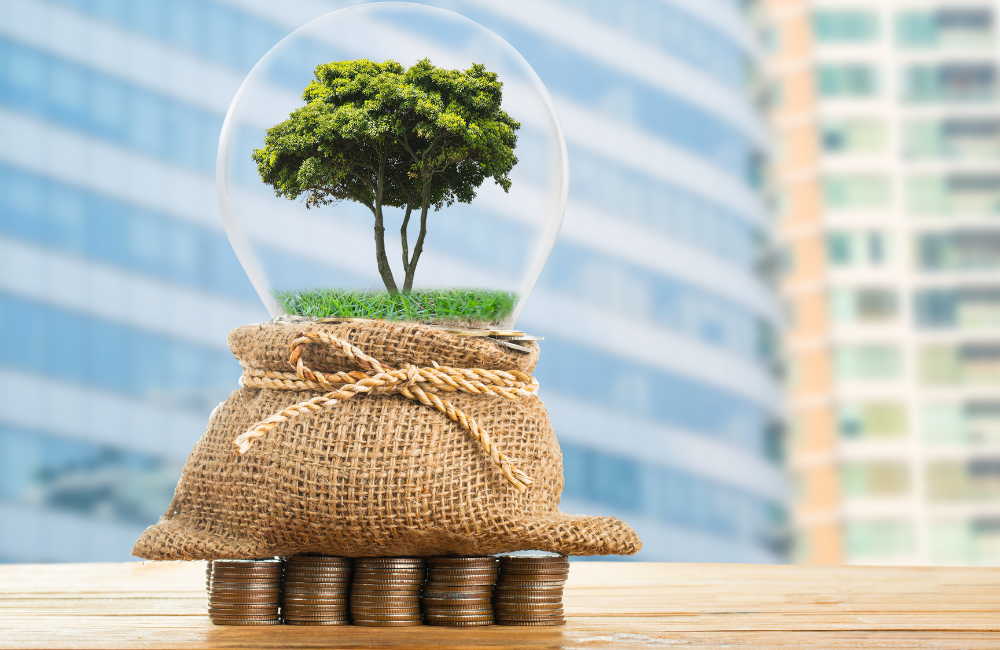
Once upon a time, investments were solely meant to draw out financial profits for investors around the globe. There wasn’t a single investor who would choose to voluntarily donate their capital, expecting nothing in return!
But times have changed, and so has the entire generation of investors, for that matter. The millennial investors have now grown more conscious and have shifted to impact investment. This substantial shift is the biggest indicator that success in the investment landscape has a wholly different meaning nowadays.
So, what does impact investment mean, and why are a majority of investors leaning towards this newfound concept? Let’s take a tour of this blog to learn in detail.

What Exactly is Impact Investment?
Let’s start our journey with the definition of this concept.
As the name suggests, impact investment refers to investing in something that has a profound effect on the betterment of society or the environment. Now, at this point, some of you might say, ‘But that’s similar to the concept of traditional philanthropy,’ right?
Well, not exactly! That’s because in philanthropy, the investors expect nothing in return. Their goal is just to achieve human welfare at the end of the day. On the contrary, investors choosing impactful investments have a different intention altogether. They want to churn out profits, along with leaving a legacy that reflects their values towards life.
However, impactful investing isn’t all about avoiding companies that pose harm to society or the environment. It is a strategy that investors use to fund projects or organizations that guarantee positive social and environmental outcomes, along with maintaining profit margins.

Types of Impact Investments
Here’s a list of the different types of impact investments that you should be aware of-
- Environmental, Social, and Governance (ESG) Investing
In this type, investors choose companies that guarantee environmental, social, and governance welfare, along with profits! The main idea behind such an investment is that companies that are Key Opinion Leaders (KOLs) in these fields are more likely to succeed in the long run.
- Socially Responsible Investing (SRI)
SRI is another type of impact investment, where the investors screen companies to invest based on ethics and principles. That’s the sole reason why such investors exclude companies manufacturing tobacco or firearms from their portfolio.
- Thematic Investing
This type includes investors who tend to invest in themes or trends that are expected to revolutionize the upcoming days. For instance, companies aiming to make use of clean, renewable energy can contribute to sustainable practices, along with churning out profits in the long run.
- Impact First Investing
Some investors prefer to opt for impact-first investing. This approach solely focuses on environmental and social impacts, while profits remain secondary on the priority list.
- Mission-Related Investing (MRI)
This is a type of impact investment where organizations make sure that their investment portfolios stay parallel to their mission. Such an approach ultimately allows these foundations to support philanthropic goals with their investment capital as leverage.
- Program-Related Investing (PRI)
This is a special type of investing where organizations make investments in order to support their charitable activities. However, when compared to MRIs, PRIs accept below-the-market returns. That’s because the primary goal here is to achieve the mission of the organization.
- Community Investing
This type of investment involves funding to local communities, who, in most cases, remain underserved and struggle to get help from traditional financial services. Community investing supports elements like affordable housing, and small businesses, which boosts local economies.
- Green and Sustainable Bonds
Investors looking to fund eco-friendly or socially beneficial projects, green and sustainable bonds are a great option for you. These are fixed-income securities that provide regular interest payments and principal return. This eventually offers a way to contribute to a better future.
A 2023 report published by the Global Impact Investing Network (GIIN) states that the impact investing market has surpassed $1.16 trillion in revenue! This is a stark reflection of the substantial shift of investors towards this specific type of investment.

Benefits of Impact Investing
So, why are more and more investors looking for the best platforms for impact investing? Let’s take a closer look-
- Firstly, if you think of yourself as an investor, you’ll feel that such a generous approach brings a profound sense of satisfaction within you! And this satisfaction stems from aligning your wealth with your values.
As of today, many investors, especially younger generations and those with a strong sense of social responsibility, are aware of rising global issues. Hence, they want their capital to be a driving force for something good. Impact investing, therefore, offers a tangible way to express the beliefs of these investors. It allows them to invest in companies and projects that actively contribute to solutions, which helps transform their portfolios into powerful agents of change. This is about active participation in building a more sustainable and equitable future.
Secondly, impact investment is continuously proving that “doing good” doesn’t necessarily mean sacrificing financial returns! Many impact-driven businesses nowadays are innovative, agile, and resilient. This forward-thinking approach leads to robust financial performance and offers unique growth opportunities. These are truly sustainable and profitable investments that demonstrate that purpose and profit can coexist and mutually reinforce each other.
Thirdly, impact investing is a great avenue for portfolio diversification. A significant portion of impact investments is made in private markets, which encompass private equity, venture capital, and private debt. These assets often have a lower correlation with traditional assets, such as stocks and bonds. This can enhance overall portfolio stability and reduce volatility, thereby providing a valuable edge for investors in uncertain economic times.
Finally, impact investment funds are inherently focused on long-term value creation. Since these investments address fundamental environmental and social challenges, they are often designed for sustainability and resilience. This long-term perspective can lead to more consistent and stable returns over time, as these solutions are built to adapt to evolving needs. These are not just fleeting trends but foundational shifts that will define future economic success.
The benefits of impact investing are increasingly more far-fetched than you can ever imagine! So, if you’re a small business operating locally, make sure to have these 6 financial tools available to streamline your workflow after you receive funding!

2025 Trends in Impact Investment
Now, let’s move on and take a look at the impact investment trends that investors are inclining to in 2025-
- Special focus on the working and poor classes
Governments across countries at present are facing huge pressure to improve lives through better jobs and opportunities. This involves boosting financial stability, access to housing, and wealth-building for all. Impact investors help bridge this gap through the mobilization of private capital towards solutions for a better quality of life, especially for the working class and the poor.
- Focus on emerging impact markets
Developing economies in places like Indonesia and Brazil have significant growth potential. Investing here can drive positive change and ensure social equality and environmental health. About 43% of investors plan to increase emerging market allocations.
- Catalytic capital
Achieving ambitious goals like sustainable growth requires innovative funding. More investors, especially high-net-worth families, are using catalytic capital to tackle problems like economic revitalization, gender equity, and climate solutions. This “patient” capital is becoming vital as the world increasingly looks up to private sources for global challenges.
- Exploring blended finance models
There has been a continued interest in blended finance, which pairs patient, risk-tolerant capital with market-rate investments. This strategy helps de-risk opportunities and unlock larger, more impactful projects. Despite ongoing challenges, recent progress has energized a lot of investors. The list comprises those who are looking to mobilize capital for specific strategies and geographies, and create new models for success.
- Asia, – the expanding market for impact investing
Asia is experiencing an exciting boom in impact investing. And the entire boom is driven by institutional and individual investors, alongside government support. Asian-based investors are increasingly pairing investments with positive outcomes. A recent GIIN report found that about 89% of Asia-focused impact investors met or exceeded financial expectations. This indicates a strong market acceleration for 2025 and beyond.
- Climate solutions
Investors are evolving their climate finance approach, moving beyond just tracking emissions to actively funding solutions. This means more investment in technologies, assets, and business models that offer low or zero-emission alternatives. Focus will be given on critical areas like sustainable agriculture, energy, food, materials, and transportation.
- Communicating ‘impact’ effectively
The impact investing industry is strong, but it needs to better connect with people seeking these solutions. Despite broad appeal, a clear narrative is important to show how impact investing addresses everyday concerns. Recent surveys have confirmed widespread support for addressing environmental and inequality issues through investments. This, in turn, highlights impact investing’s resonance across diverse audiences.
Pro Tip: Want to actively contribute to impactful investments? Follow these mindful financial habits to stop being a spendthrift; and have enough funds to invest in green and social bonds seamlessly.
Impact Investments: Is it the Future?
Impact investment is not just any trend that will fade away with time. Rather, it is one of the newfound concepts that has totally revolutionized the way that investors perceive the purpose of capital. It’s about realizing that financial assets aren’t mere instruments of profit, but can also be a powerful force to drive a positive change.
Investors nowadays are demanding more than profits from their investments. What they want now is for their investments to be a reflection of their value, while generating financial gains.
Along with it, reports and studies from the Global Impact Investing Network (GIIN) are also echoing the growing market size of impact investments. That, tagged along with the growing trends of sustainability, is what drives investors towards impact investing in today’s day and age.
![]()

Amilia Brown is a seasoned business writer & strategist who simplifies complex business concepts and turn them into engaging narratives. As a trusted business writer, she delivers actionable insights with precision.








